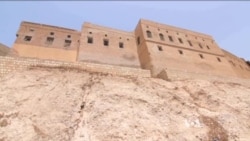After standing for more than 8,000 years, the recent closure and re-opening of Irbil Citadel may seem like just another chapter in its long, rich history.
But even in the context of millennia, as efforts to save and restore the world heritage site in northern Iraq continue, the stakes are high.
A cradle of civilization within a region where heritage is under threat, the Citadel’s labyrinthine streets have been home to countless generations.
And now, due partly to the violence being unleashed in Syria and Iraq, efforts to revive it for future generations are threatening to stall.
The crown of Irbil
Major regeneration work to preserve and restore the Citadel began in 2007, along with efforts to investigate the layers of history that beneath its surface.
For Dara al-Yaqubi, head of the High Commission for Irbil Citadel Revitalization, the work is about more than just preservation. Dubbing it “the crown of Irbil” and the pride of the Kurdish people, he says the ultimate aim is to make the site not just a celebration of the past, but an inspiration for the future.
“We need to take care of the building, to renovate it and to rehabilitate it so that life can come back again to the Citadel, but with a clear difference," he said.
“Previously it was residential, but, now, like the historic area of many towns, it could be used as a tourist and cultural space,” al-Yaqubi said, adding that the aim was to make the Citadel once again a thriving hub within Irbil.
Though it dominates the skyline of Iraqi Kurdistan’s capital, the Citadel is anything but thriving.
Cash issues
Claimed by some to be the longest continuously inhabited town in the world, Irbil has seen the site occupied by the likes of the Abbasid Caliphate and the Ottoman empire, and even saw it ransacked by the Mongols.
However, it gradually became depopulated over the 20th century, and, by 2006, was largely inhabited by refugee families seeking shelter from the violence and instability in the region.
Though the refugees have been relocated within Irbil, the instability has continued and slowed work on the project.
With large quantities of Iraqi and Kurdish government funding being diverted to combating the Islamic State group, funding for work on the site is proving harder to come by.
Meanwhile, dropping oil prices and political tensions between Baghdad and the Kurdish regional government — restricting the flow of funds from the former to the latter — have also had an adverse effect on resources.
“Unfortunately because of this financial difficulty in all of Iraq and Kurdistan, we’re facing difficulties,” said al-Yaqubi. “So our activities have become a little bit slow.”
Al-Yaqubi maintains it is a situation out of his control and that the organization can only wait. Asked when the work will be completed, he says: “when we receive enough money."
Dwindling numbers
The delay is being felt by the few who have already set up businesses in the Citadel.
The site, which was closed most recently for restoration of the main street, remains very much a work in progress.
Since its re-opening a few weeks ago, visitors have trickled through, but in nothing like the numbers of previous years, explained Lolan Sipan.
A regular visitor to the Citadel all his life, Sipan set up the Kurdish Textile Museum in 2005.
He smiles at memories of what he called a “joyful” place.
But having enjoyed hundreds of guests daily before the renovations really took hold, including prominent figures such as former Republican presidential candidate John McCain, Sipan is now struggling to make ends meet.
“It’s very depressing,” he said. “We were expecting by the end of 2014 or mid-2015 that we would have more galleries, museums, cafes, restaurants and handicrafts, and that families could come, but that didn’t happen.”
Sipan acknowledges, however, that the work is necessary, and he insists the potential to draw tourists remains.
He nods toward the closed southern gate, which provides access to Irbil’s Bazaar district. "If that was open, we would definitely have hundreds of tourists in here again,” he said.
Added urgency
Despite slow progress, many insist the restoration will push ahead. A project to revitalize 14 homes was recently completed, and a total of 200 are slated for restoration.
Meanwhile, UNESCO, which is lending its expertise to the project, placed the Citadel on its World Heritage List.
While funds may be slow to materialize, the sense of urgency is only amplified by the destruction of antiquities elsewhere in the region.
UNESCO project officer May Shaer called the Citadel a “priority,” with restoration “critical to preserve the buildings for future generations.”
And with the violence being inflicted on people and their heritage by Islamic State — which controls Mosul, just 90 kilometers from Irbil — Shaer also sought to put the restoration in a broader context.
"In light of what is happening in terms of the destruction in Iraq and Syria, more than ever before we need to highlight the importance of heritage and cultural diversity,” she said, referring to the recent destruction of places such as the Assyrian city of Nimrud.
Her words come in the wake of the U.N.'s recent adoption of a unanimous resolution to "Save the Cultural Heritage of Iraq," as well as the launch of UNESCO’s #Unite4Heritage social media campaign.
“It’s time to really focus on preservation of heritage as a tool to preserve the identity of people of a country and a unity of people,” she added.











